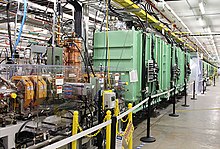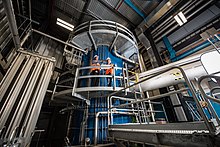Facility for Rare Isotope Beams
The Facility for Rare Isotopes Beams (FRIB) will be a new scientific accelerator facility for nuclear science, funded by the U.S. Department of Energy Office of Science (DOE-SC), Michigan State University (MSU), and the State of Michigan. Under construction on the MSU campus and to be operated by MSU as a DOE-SC national user facility, FRIB will provide intense beams of rare isotopes (that is, short-lived atomic nuclei not normally found on Earth). FRIB will enable scientists to make discoveries about the properties of rare isotopes to advance knowledge in nuclear physics, nuclear astrophysics, fundamental interactions of nuclei, and applications of rare isotopes for society. Construction of the FRIB conventional facilities began in spring 2014 and was completed in 2017. Final design of the technical systems is complete and technical construction is underway, having started in the fall of 2014. The total project cost is baselined at $730M with project completion in June 2022.1
| Facility for Rare Isotope Beams (FRIB) | |
|---|---|
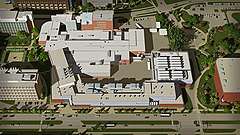 The Facility for Rare Isotopes Beams (FRIB) will be a new scientific accelerator facility for nuclear science, funded by the U.S. Department of Energy Office of Science (DOE-SC), Michigan State University (MSU), and the State of Michigan. | |
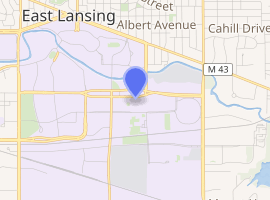
| |
| General information | |
| Type | National User Facility |
| Address | 640 South Shaw Lane, East Lansing, MI 48824 |
| Town or city | East Lansing, Michigan |
| Country | United States |
| Coordinates | 42°43′29.21″N 84°28′25.78″W |
| Completed | June 2022, managing to early completion in 2021 |
| Cost | US$765 million (Total Project Cost) |
| Owner | Michigan State University |
| Technical details | |
| Floor area | 220,160 sq ft (20,454 m2) |
| Design and construction | |
| Architecture firm | SmithGroup JJR |
| Main contractor | Barton Malow |
| Website | |
| FRIB Website | |
FRIB is expected to provide research opportunities for an international community of university and laboratory scientists, postdoctoral associates, and graduate students. FRIB will provide researchers with the technical capabilities to study the properties of rare isotopes, and to put this knowledge to use in various applications, including in materials science, nuclear medicine, and the fundamental understanding of nuclear material important to nuclear weapons stockpile stewardship. More than 20 working groups specializing in experimental equipment and scientific topics have been organized through the FRIB Users Organization.2
DOE-SC determined that the establishment of a Facility for Rare Isotope Beams (FRIB) is a high priority for the future of U.S. nuclear science research. It is the first recommendation in the 2012 National Academies Decadal Study of Nuclear Physics: Nuclear Physics: Exploring the Heart of the Matter. The priority for completion is listed in the 2015 Long Range Plan for Nuclear Science: Implementing Reaching for the Horizon by the DOE/NSF Nuclear Science Advisory Committee.
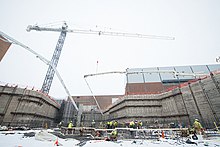

Developments
DOE-SC announced the selection of Michigan State University to design and establish FRIB on December 11, 2008 after a rigorous merit review process including a written application, oral presentations, and site visits.[1]
The project earned Critical Decision 1 (CD-1) approval in September 2010 which established a preferred alternative and the associated established cost and schedule ranges.[2]
On August 1, 2013, DOE-SC approved the project baseline (CD-2) and the start of civil construction (CD-3a), pending a notice to proceed. Civil construction could not start under the continuing appropriations resolution, which disallowed new construction starts.[3]
January 18, 2014 the appropriations bill passed both houses of congress.
Following the passage of the FY2014 appropriation, DOE-SC issued a notice to proceed on January 22, 2014, allowing the start of civil construction.[4]
On February 25, 2014 the board of the Michigan Strategic Fund[5] met at Michigan State University and approved nearly $91 million to support the construction of FRIB.[6]
FRIB marked the official start of civil construction with a groundbreaking ceremony March 17, 2014. In attendance were representatives from the Michigan delegation, State of Michigan, Michigan State University, and the U.S. Department of Energy Office of Science. Technical construction started in October 2014, following a CD-3b approval by DOE-SC.
In March 2017, FRIB achieved beneficial occupancy of civil construction, and technical installation activities escalated as a result.
In September/October 2017, the front end with the ion source and low-energy beam transport were completed.
The FRIB cryogenic plant made its first liquid helium at 4.5 Kelvin (K) in November 2017. Liquid helium makes FRIB's accelerator cavities superconducting and is needed to operate FRIB's superconducting linear accelerator.
The 4 K cryogenic plant was completed in December 2017, and in July 2018, following two days of commissioning, beams of argon and krypton were accelerated in the first three superconducting cryomodules to the Key Performance Parameters required at project completion. Cryomodule production is now at peak capacity, with the project team building nine cryomodules per six months.

Notes
- "Fact Sheet". Department of Energy. Retrieved November 12, 2008.
- Miller, Matthew. "Feds OK design concept for MSU nuclear physics facility" (PDF). Lansing State Journal. Archived from the original (PDF) on November 7, 2013. Retrieved September 9, 2010.
- Glasmacher, Thomas. "DOE Office of Science Approves CD-2 and CD-3a". FRIB. Retrieved August 5, 2013.
- Glasmacher, Thomas. "FRIB Construction to Begin in Early Spring". FRIB. Retrieved November 23, 2016.
- "Michigan Strategic Fund | About MEDC | Michigan Business".
- Miller, Matthew. "State OKs 91M for MSUs FRIB". Lansing State Journal. Retrieved February 25, 2014.
References
- "Michigan State's $765 million nuclear research facility set to open in 2021". Crain's Detroit Business. Associated Press. August 5, 2019.
- Mark Johnson (July 29, 2019). "Facility for Rare Isotope Beams '92 percent complete'". Lansing State Journal.
- RJ Wolcott (August 15, 2018). "A decade later, Facility for Rare Isotope Beams director can see the finish line". Lansing State Journal.
- Cryogenic Society of America, Inc. (January 8, 2018). "MSU Establishes Cryogenic Initiative at FRIB". Cold Facts.
- RJ Wolcott (December 22, 2017). "Michigan State plans $35 million in additional technology, new building for FRIB". Lansing State Journal.
- Adrian Cho (November 24, 2017). "An earthly search for gold's cosmic origins". Science.
- MSU Today (November 16, 2017). "MSU to establish training program to address national shortage in accelerator scientists, engineers". Fox 47.
- Steve Carmody (September 24, 2017). "MSU's FRIB project reaching a milestone". Michigan Radio NPR.
- Garret Ellison (December 17, 2015). "MSU nuclear research facility gets $100M". MLive.
- Nicole Chadwick (September 21, 2015). "Inside the FRIB". WILX TV-10.
- Eugenie Samuel Reich (August 30, 2011). "Isotope factory accelerates". Nature. Archived from the original on March 15, 2016.
- Lori Higgins (January 18, 2011). "Nuclear research has MSU beaming". Detroit Free Press.
- Marisa Schultz (December 12, 2008). "MSU awarded $550M isotope lab". Detroit News.
- Adrian Cho (December 11, 2008). "Michigan State Picked for Half-Billion-Dollar Accelerator". Science. Archived from the original on June 21, 2013. Retrieved December 6, 2011.
